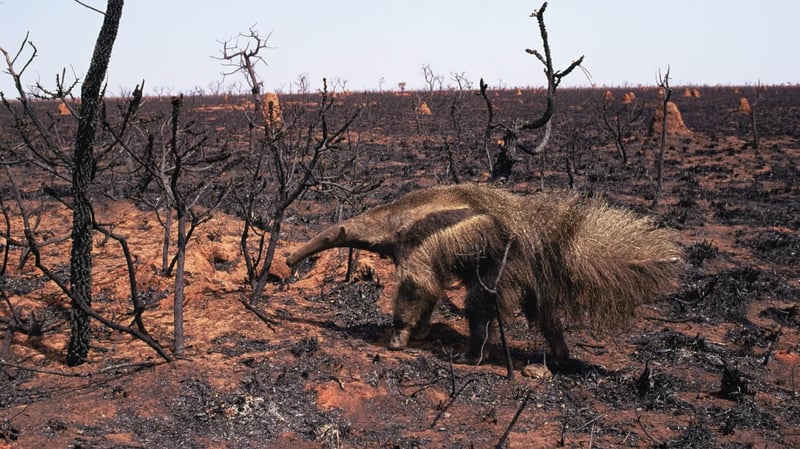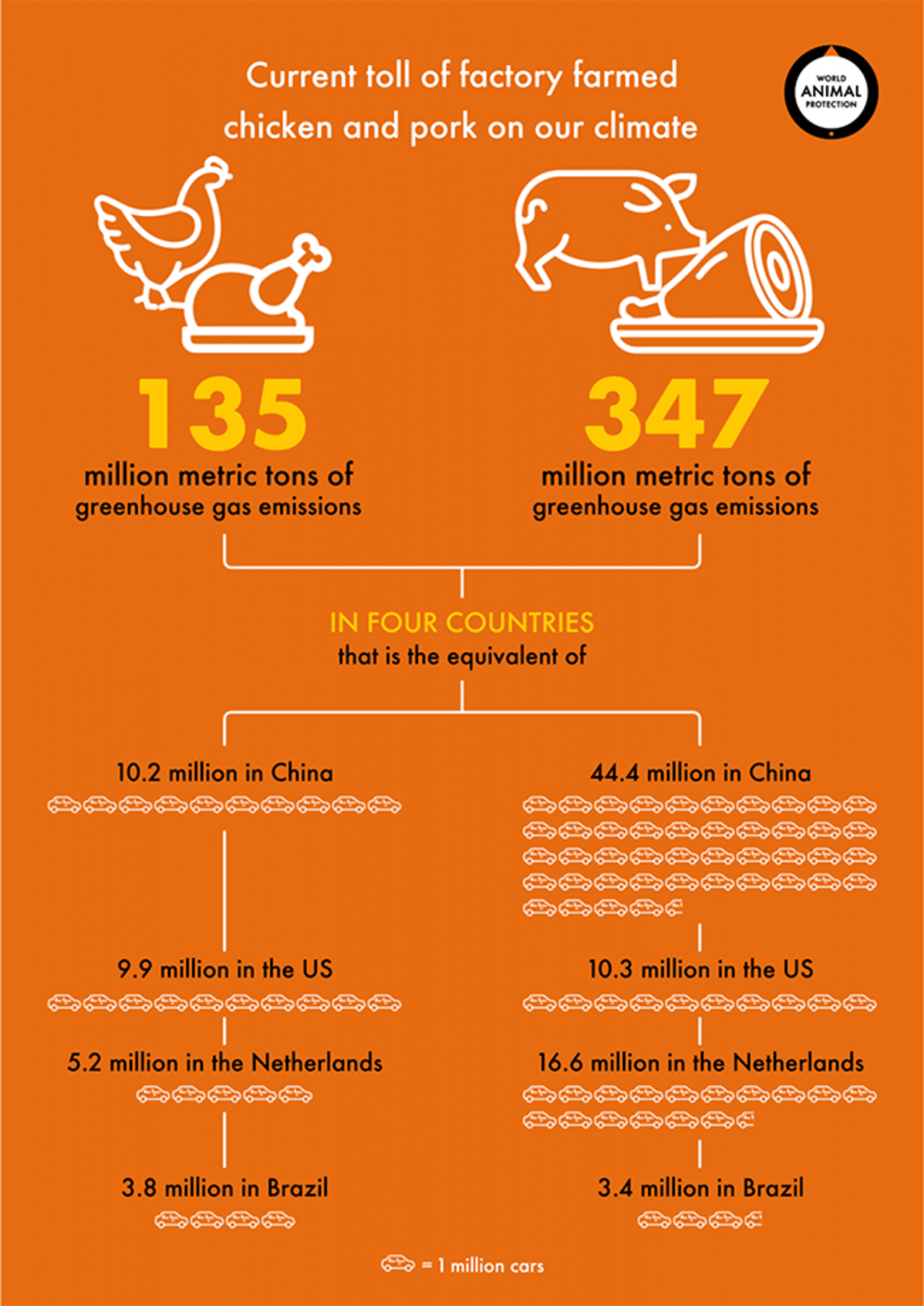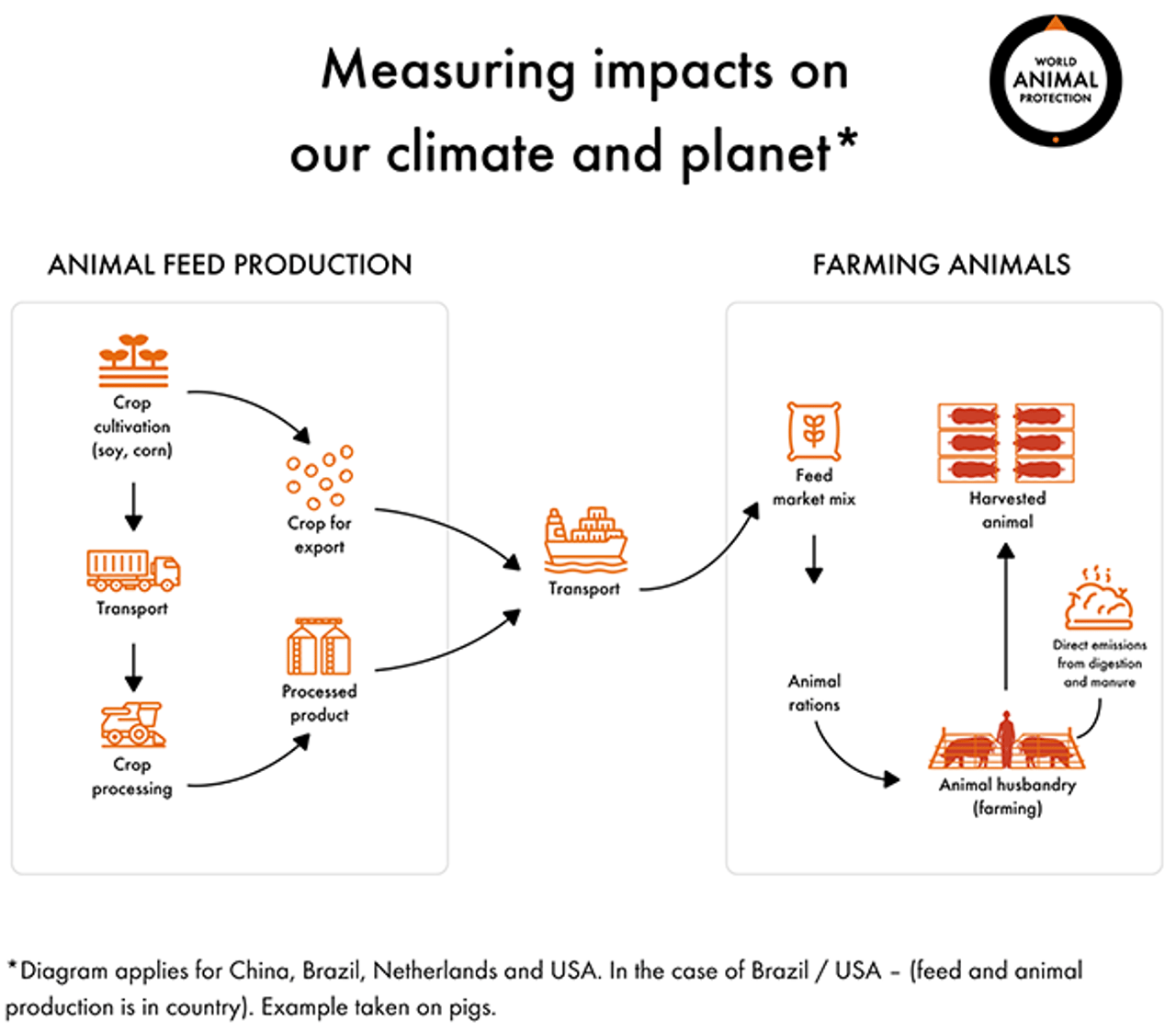
Our food system is now coming under the spotlight in the race to find solutions to climate change. Governments must stop overlooking the rapidly escalating toll that factory farming is taking on our planet.
Climate change causes and solutions research
Earlier this year, the expert IPCC panel called for action to address climate change in our food system. The panel emphasised that even if all fossil fuel emissions were immediately eliminated, food system emissions alone would jeopardise the goal to limit global warming to well below 2ºC and preferably 1.5ºC.
Factory farming is almost always overlooked as a climate culprit within the food and agriculture sector. Yet, with ballooning demand for meat in many parts of the world, research commissioned by World Animal Protection has captured the alarming climate toll of pork and poultry consumption in the world’s biggest factory farming hot spots. However, there are solutions to tackle climate change: through substantial reductions in meat consumption.
Climate impacts of factory farming
Pork and chicken are often overlooked as contributors to climate change, despite a staggering 69 billion meat chickens and 1.5 billion pigs produced annually, mostly in cruel factory farms.
The report “Climate change and cruelty” captured the environmental and climate change impacts of farmed pork and chicken meat production in the world’s four biggest factory farming hot spots: Brazil, China, the USA and the Netherlands (representing Europe).
The researchers collected data on the production of crops to feed farmed animals, from the levels of water and energy used in growth and processing, through to the use of pesticides and fertilisers and the impact of transportation once the crop is harvested.
They also collected data from existing reports and industry experts on: the energy use in factory farms for lighting and heating; the greenhouse gases created by animal manure; and the transport emissions produced by the farming industry. They then used this baseline data to model future scenarios of climate and environmental impact in 2030, 2040 and 2050.
The research found that currently, emissions across the factory farming hot spots are equivalent to keeping 29 million cars on the road for a year.
Animal feed production is especially destructive
The most significant climate change and environmental impacts within the factory farming system are created by the production of crops used to feed farmed animals. Increasing global demand for animal feed crops drives deforestation, causing carbon to be released into the atmosphere when the trees are cut down and the soil is disturbed by farming.
Our global food system is broken and inefficient
Brazil is the world’s largest producer and exporter of soy crops to feed farmed animals, while also using feedstock for its own factory farmed animals. When deforestation for growing crops to feed farmed animals is considered, it more than triples the climate impact of meat chicken production in Brazil.
Equally, when looking at the carbon impact of factory farming in countries that depend on imports of animal feed from Brazil and elsewhere, this doubles the overall climate change impact of factory farmed meat in the Netherlands and increases the impact by more than one and a half times in China.
Ultimately, using land to grow crops to feed farmed animals that will eventually become our food, is a highly inefficient and destructive practice. For every 100 calories of crops fed to farmed animals, only 17-30 calories reach humans in our food chain. Meat and dairy provide only 18% of overall calories and 37% of protein for humans, but they use 83% of farmland. It is far better to grow crops that feed humans directly through plant-based diets. This is the strongest path to food security.
Solutions to tackle climate change and animal cruelty
Right now, every year more than 80 billion animals are farmed, most condemned to factory farms where their lives are brief and full of suffering. Meat chickens exist squashed against tens of thousands of other chickens, with no room to flap their wings or perch like they would naturally.
A mother pig lives her life in a cage, unable to turn around, often biting the steel bars around her in frustration, causing injuries. Her piglets are stripped from her as early as 21 days old, their tails and teeth are cut and males are castrated.
The environmental benefits of eating less meat measured
The research commissioned by World Animal Protection is the world’s first study to measure the potential climate and environmental benefits of eating less factory farmed chicken and pork, while simultaneously ending the cruellest practices on factory farms and improving living conditions for the billions of animals currently trapped within them.
It finds that there is no significant difference between the climate impacts of conventional factory farming and higher welfare factory farming where pigs are no longer kept in cages, meat chickens have more room to move, animals are not mutilated, and higher welfare breeds of animals are used to ensure they grow at a rate that does not impose painful health problems on them.
This means there is no excuse for the industry to avoid ending the cruellest practices for animals that remain on factory farms.
The best way to protect animals and fight climate change
Increases in overall meat consumption in the coming decades will further exacerbate the climate impacts of factory farming.
Researchers also measured the impact of diets containing less chicken and pork, as well as scenarios when people ‘eat less and better’, meaning they not only eat less chicken and pork, they also choose higher welfare meat when they do.
Eating less and better
They find that a 50% reduction in consumption of both chicken and pork by 2040, along with a 50% adoption of higher welfare products would halve the annual climate impacts of chicken and pork production across these four hot spots. This would be equivalent to taking 45 million cars off the road for a year in the four hot spots combined.
The best way to protect animals and tackle climate change is to end factory farming, starting with a ban on new factory farms. Substantial reductions in meat production and consumption will help to damage factory farming financially and unlock the humane and sustainable future we need.
Factory farming is not a precondition for food security – it undermines it. Although our research focuses on specific factory farming hot spots, the global message is clear - we need to rethink the current drive to build more factory farms in parts of the world where demand for meat is rising most sharply. More factory farms would take a heavy toll on our climate while condemning billions more animals to lives of suffering.
World Animal Protection is calling for governments to respond to climate change by:
- Stopping approving new factory farms now. Governments are the key player in subsidizing factory farming. They have the power to shift policy and funding decisions away from factory farming in support of humane and sustainable food systems.
- Introducing and enforcing minimum farmed animal welfare standards (FARMS), to end the worst forms of suffering on remaining factory farms.
How you can help
- Join our call on governments to stop approving new factory farms now;
- Eat less and better. By consuming fewer animal products and choosing higher welfare options. you can help to protect our climate, planet, and animal welfare.

